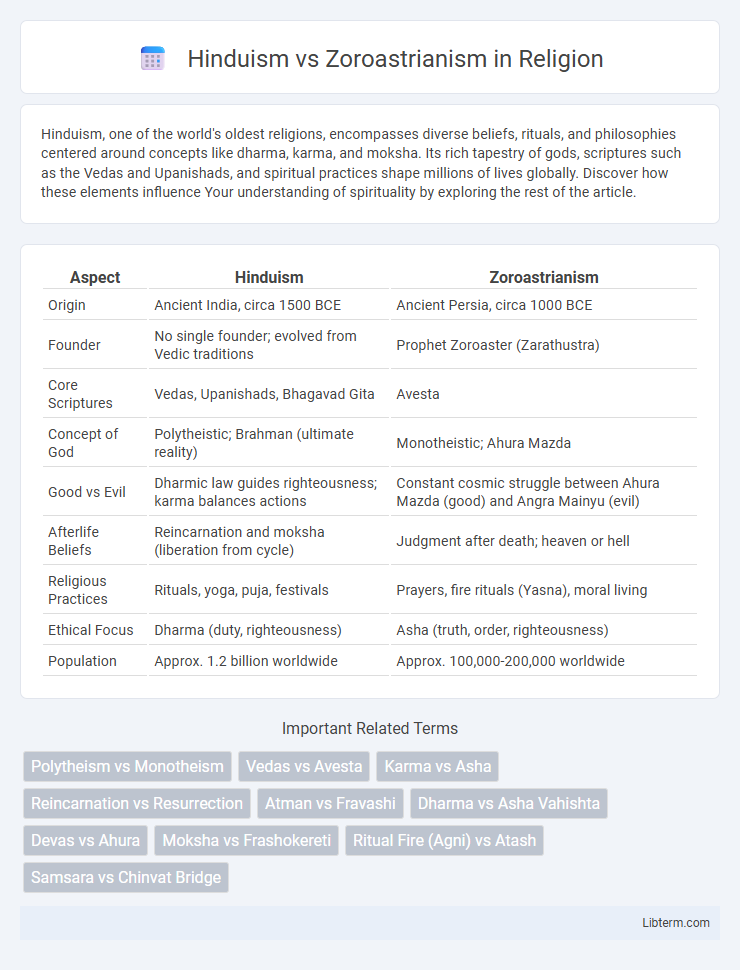Hinduism, one of the world's oldest religions, encompasses diverse beliefs, rituals, and philosophies centered around concepts like dharma, karma, and moksha. Its rich tapestry of gods, scriptures such as the Vedas and Upanishads, and spiritual practices shape millions of lives globally. Discover how these elements influence Your understanding of spirituality by exploring the rest of the article.
Table of Comparison
| Aspect | Hinduism | Zoroastrianism |
|---|---|---|
| Origin | Ancient India, circa 1500 BCE | Ancient Persia, circa 1000 BCE |
| Founder | No single founder; evolved from Vedic traditions | Prophet Zoroaster (Zarathustra) |
| Core Scriptures | Vedas, Upanishads, Bhagavad Gita | Avesta |
| Concept of God | Polytheistic; Brahman (ultimate reality) | Monotheistic; Ahura Mazda |
| Good vs Evil | Dharmic law guides righteousness; karma balances actions | Constant cosmic struggle between Ahura Mazda (good) and Angra Mainyu (evil) |
| Afterlife Beliefs | Reincarnation and moksha (liberation from cycle) | Judgment after death; heaven or hell |
| Religious Practices | Rituals, yoga, puja, festivals | Prayers, fire rituals (Yasna), moral living |
| Ethical Focus | Dharma (duty, righteousness) | Asha (truth, order, righteousness) |
| Population | Approx. 1.2 billion worldwide | Approx. 100,000-200,000 worldwide |
Origins and Historical Development
Hinduism originates from the ancient Indus Valley civilization around 2500 BCE, evolving through the Vedic period marked by sacred texts like the Rigveda. Zoroastrianism began with the prophet Zoroaster in ancient Persia around the 6th century BCE, emphasizing monotheism centered on Ahura Mazda. Both religions have profoundly influenced cultural and religious landscapes, with Hinduism developing complex rituals and philosophies, while Zoroastrianism shaped early concepts of dualism and ethical monotheism.
Foundational Texts and Scriptures
Hinduism's foundational texts include the Vedas, Upanishads, and the Bhagavad Gita, which collectively explore dharma, karma, and moksha through hymns, philosophies, and epic narratives. Zoroastrianism centers around the Avesta, with the Gathas--hymns attributed to the prophet Zarathustra--forming its core, emphasizing the duality of good and evil and the importance of moral choice. Both traditions rely on oral transmission followed by codification, shaping their theological frameworks and ritual practices.
Core Beliefs and Philosophies
Hinduism centers on concepts like dharma (duty), karma (action and consequence), samsara (cycle of rebirth), and moksha (liberation from the cycle), emphasizing a diverse pantheon and spiritual practices. Zoroastrianism emphasizes the dualistic battle between Ahura Mazda (the Wise Lord) and Angra Mainyu (destructive spirit), highlighting the importance of truth (asha), righteous living, and the eventual triumph of good over evil. Both religions uphold moral responsibility but differ in metaphysical views, with Hinduism embracing cyclical time and reincarnation, while Zoroastrianism supports linear progression toward a final judgment and purification.
Concepts of God and Divine Entities
Hinduism embraces a complex pantheon with Brahman as the ultimate, formless reality, while numerous deities like Vishnu, Shiva, and Devi personify various aspects of this supreme truth. Zoroastrianism centers on Ahura Mazda as the singular, supreme God embodying wisdom and goodness, with lesser divine entities such as Amesha Spentas representing moral and cosmic principles. The contrast lies in Hinduism's pluralistic divine manifestations versus Zoroastrianism's strict monotheism emphasizing a cosmic dualism between good and evil forces.
Rituals and Religious Practices
Hinduism features elaborate rituals such as puja, yajna (fire sacrifices), and samskaras, emphasizing worship of deities, meditation, and temple ceremonies. Zoroastrianism centers on purity rituals, including the kusti girding ceremony and prayers at the fire temple, with fire symbolizing divine presence. Both religions incorporate daily prayers and seasonal festivals, maintaining a strong focus on community participation and spiritual discipline.
Perspectives on Life, Death, and Afterlife
Hinduism views life as a cycle of birth, death, and rebirth governed by karma, with the ultimate goal of achieving moksha, or liberation from the cycle of samsara. In contrast, Zoroastrianism emphasizes a linear progression of life followed by judgment, where souls are judged based on their deeds and sent to either heaven or hell. While Hinduism embraces reincarnation and spiritual evolution, Zoroastrianism focuses on moral dualism and final resurrection.
Ethics, Morality, and Law
Hinduism emphasizes dharma, a complex ethical framework guiding individual duties, righteousness, and cosmic order, promoting karma and moral actions that influence reincarnation. Zoroastrianism centers on the triad of good thoughts, good words, and good deeds, fostering a clear dualistic morality where the struggle between truth (asha) and falsehood (druj) dictates ethical behavior and spiritual law. Both religions integrate their moral principles deeply into law and social conduct, with Hinduism's varna and ashrama systems and Zoroastrianism's emphasis on purity and justice shaping adherents' lives.
Influence on Society and Culture
Hinduism and Zoroastrianism have profoundly shaped their respective societies through foundational ethical principles and ritual practices that influence social norms and cultural traditions. Hinduism's caste system and extensive mythology permeate Indian art, literature, and festivals, fostering a diverse cultural landscape rooted in Dharma and Karma. Zoroastrianism's emphasis on truth, purity, and cosmic dualism has significantly impacted Persian cultural identity, inspiring concepts of moral responsibility and influencing religious thought in Abrahamic faiths.
Modern-Day Followers and Demographics
Hinduism, with over 1.4 billion adherents, predominantly resides in India, Nepal, and the global Indian diaspora, representing the world's third-largest religion. Zoroastrianism, a much smaller faith with approximately 100,000 to 200,000 followers worldwide, is primarily concentrated in India (Parsis) and Iran, maintaining a declining but culturally significant presence. Demographic trends show Hinduism growing steadily through birth rates and conversions, while Zoroastrianism faces challenges of assimilation and decreasing population.
Comparative Legacy and Global Impact
Hinduism, as one of the world's oldest religions, has deeply influenced South Asian culture, philosophy, and social systems through concepts like karma, dharma, and moksha, which continue to shape millions of lives globally. Zoroastrianism, though smaller in following, significantly impacted religious thought in the ancient world, introducing dualistic themes of good versus evil and influencing Abrahamic faiths such as Judaism, Christianity, and Islam. The comparative legacy of these religions highlights Hinduism's extensive cultural integration and Zoroastrianism's foundational role in shaping early ethical monotheism and global religious paradigms.
Hinduism Infographic

 libterm.com
libterm.com